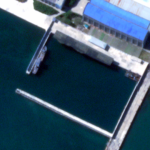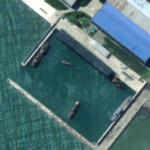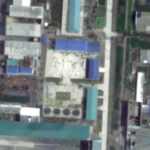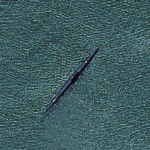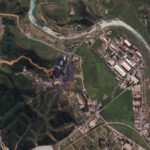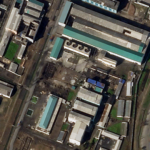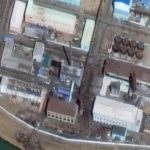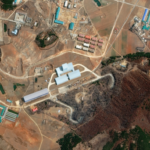October 5, 2020, by Joseph S. Bermudez Jr. and Victor Cha—
With the upcoming Korean Workers’ Party Foundation Day celebration on October 10, a SLBM test should not be ruled out as a possibility for Kim Jong-un’s self-proclaimed “October surprise.” Such a test would be consistent with Beyond Parallel historical data that shows heightened provocations around U.S. presidential election years.
September 9, 2020, by Joseph S. Bermudez Jr.—
An unidentified approximately 12-meter-by-1.75-meter yellow trailer or truck is on the same dock but immediately outside the secure boast basin. Speculation is that this may be a piece of construction equipment (e.g., a crane) or trailer transporting a missile container. We must reiterate that the resolution of the current image precludes positive identification so caution is urged.
September 8, 2020, by Joseph S. Bermudez Jr. and Dana Kim—
The Hungnam Fertilizer Complex has long been associated with producing chemical feed stocks or agents for North Korea’s nuclear weapons, chemical weapons and ballistic missile programs. Any modernization or improvement in its production capacities warrant close monitoring as they have the potential to support or augment WMD capabilities.
September 4, 2020, by Joseph S. Bermudez Jr. and Victor Cha—
A satellite image of the Sinpo South Shipyard acquired on September 4, 2020 shows some activity within the secure boat basin that is suggestive, but not conclusive, of preparations for an upcoming test of a Pukguksong-3 submarine launched ballistic missile (SLBM) from the submersible test stand barge based here.
August 27, 2020, by Joseph S. Bermudez Jr., Victor Cha and Bonny Lee—
The Pyongsan Uranium Concentrate Plant represents a critical component of North Korea’s nuclear research and weapons development programs. Through analysis of 100+ medium- and high-resolution declassified and commercial satellite images, this report aims to provide a new and unique look into the facility. It is also the second publication in a series analyzing North Korea’s uranium concentrate plants as well as one of the most comprehensive collections of unclassified information and satellite imagery presently available of the Pyongsan facility.
June 16, 2020, by Joseph S. Bermudez Jr. and Victor Cha—
The latest undertaking at the Hungnam Fertilizer Complex, one of North Korea’s oldest and largest chemical complexes, is the construction of a small “liquid nutrient fertilizer factory.” The construction and future operation of this new liquid nutrient fertilizer factory is a further manifestation of the continuing efforts under Kim Jong-un to increase agricultural production by expanding and diversifying domestic fertilizer production capabilities.
May 29, 2020, by Joseph S. Bermudez Jr. and Victor Cha—
The Pyongsan Uranium Concentrate Plant (38.318369 N, 126.432360 E) is located in Pyongsan-gun (평산군, Pyongsan County), Hwangbuk-do (황북, North Hwanghae Province), approximately 45 kilometers from the DMZ and 96 kilometers northwest of Seoul—the capital of South Korea. Since approximately 1990 it has occupied an critical role in the Democratic People’s Republic of Korea’s (North Korea) nuclear research and weapons programs as the sole known provider of uranium oxide (yellowcake) to these programs for fuel fabrication or enrichment.
May 5, 2020, by Joseph S. Bermudez Jr.—
In a joint baseline analysis with Jane’s Intelligence Review, the Center for Strategic and International Studies surveys a previously undisclosed facility near Pyongyang International Airport in North Korea that is likely related to its expanding ballistic missile development program.
May 4, 2020, by Joseph S. Bermudez Jr. and Marie DuMond—
Widely considered as a midterm referendum on President Moon, the April electoral victory will breathe new life into his administration’s heretofore stalled diplomatic efforts with North Korea, a key pillar of which is inter-Korean railway cooperation. In the context of South Korea's renewed efforts in inter-Korean railway cooperation, Beyond Parallel reviews the railway connections of the Korean peninsula.
March 11, 2020, by Joseph S. Bermudez Jr.—
Declassified April 1972 satellite imagery the Yongbyon Nuclear Research Center show developments which taken as a whole continue to represent both an ongoing first-phase construction project for the facility and early infrastructure development efforts within a longer-term plan for future expansion. This work laid the foundations for the construction of the facility’s first waste storage facility in the years to follow and the massive second phase expansion that would begin during the early-1980s.
